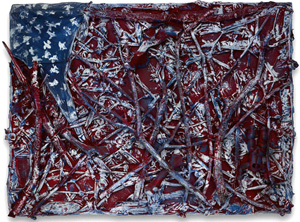1.24.25 — Dancing in the Dark
The largest gallery at the Whitney just got bigger. It has knocked down nearly every wall, leaving a dance theater that Alvin Ailey himself could never have experienced. For a more impressive stage, he would have had to turn to New York itself.
It is also an exhibition space—as capacious, the museum hopes, as African American art. It sees Ailey as a guide to the story of that art, including art that he may never have known. It must sound ridiculous. Who would attempt to tell that story in an exhibition or even two, no more than the story of Western or global art? It risks condescending to black artists by pretending that it can.  And yet it succeeds, for theater becomes art and art becomes theater, as “Edges of Ailey,” through February 9, while an Ailey veteran, Ralph Lemon, at MoMA PS1 reaches for the stars.
And yet it succeeds, for theater becomes art and art becomes theater, as “Edges of Ailey,” through February 9, while an Ailey veteran, Ralph Lemon, at MoMA PS1 reaches for the stars.
This is epic theater. Works from more than eighty artists, many as large as a human performer, take the spotlight before disappearing into a greater darkness. Some occupy islands within “Edges of Ailey,” and you can circulate around and between them. Right off, that knocks out any hope for a chronological exhibition or even a story, but do not despair. The rest line the walls, as you would expect, and articulate the show’s themes. Smaller spaces at each end of the floor tell Ailey’s own interdisciplinary story.
Born in 1931, he studied with Stella Adler—not a choreographer, but a renowned acting teacher. He acknowledged the influence of Langston Hughes, James Baldwin, and Duke Ellington, and the show returns often to the Harlem Renaissance, painting and dance, black experience, and music, particularly jazz. He credited Geoffrey Holder as well, a friend who moved easily between the stage and art. Ailey founded the American Dance Theater in 1958, with thirty-two dancers and two directors. There, too, he was thinking of influence, collaboration, and community. He died in 1989 of AIDS.
The show includes publicity posters, playbills, and film clips culled from thousands of hours, and scheduled performance continues downstairs in the museum’s theater and on its roof as well. It has color photos of Ailey himself dancing, lingering on not just his movements, but his expressive face. Ailey made the scene in all sorts of ways. The ABT performed at the opening of Studio 54, the epitome of a club scene that would never admit you. And the show’s only window overlooks a Hudson River pier that served as a gay pick-up spot. The AIDS quilt bars the view.
Overhead on the show’s fantastic stage, choreography, too, lines the walls, in one long video collage spanning eighteen screens. It adds color, like the yellow robes of dancers. It provides a constant background of music, even if you look instead at the art. Mahalia Jackson introduces a work with music by Ellington, barely mentioning Ailey. This is his achievement all the same. It just happens to come down to two distinct exhibitions, for dance and for art.
The show is itself a collaboration, between the Whitney and the Alvin Ailey Dance Foundation. Neither is willing to let Ailey’s work die with him. Nor are the curators, Adrienne Edwards with Joshua Lubin-Levy. They could have included only art that the choreographer admired or influenced, and perhaps they do. If so, he knew and influenced a lot. And that still leaves open just how present he is in the art—and I wrap this up next time with the art itself.
Read more, now in a feature-length article on this site.